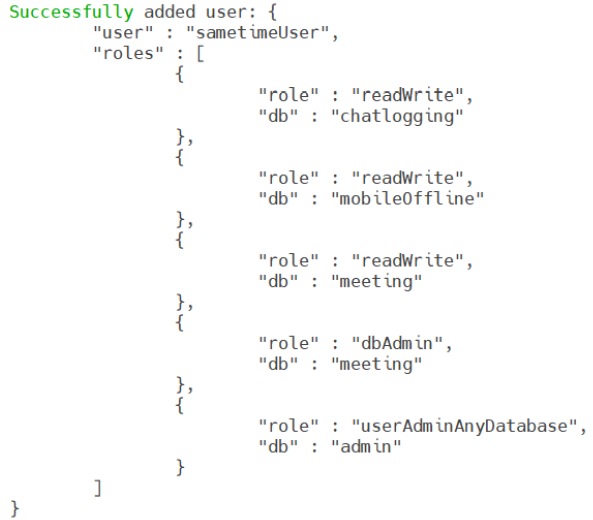Configuring MongoDB for Sametime
This topic describes how to configure MongoDB on both Windows and Linux platforms to support Sametime and Sametime Premium deployments.
About this task
Note: In the
following steps, MongoDB version 6.0 is used as an example. If you are using a different
version of MongoDB, refer to the official MongoDB documentation for how to issue
commands for the version that you are using.
Procedure
- Access the Mongo Shell on the Primary node of the MongoDB cluster.
-
Run the db.createUser()method to add the user administrator. The
following example creates the user sametimeAdmin with the
userAdminAnyDatabase role on the admin database.
admin = db.getSiblingDB("admin") admin.createUser( { user: "sametimeAdmin", pwd: "sametime", // or cleartext password roles: [ { role: "userAdminAnyDatabase", db: "admin"}, {role:"readWrite", db:"chatlogging"}, {role:”dbAdmin”,db:”chatlogging”}, {role:"readWrite", db:"mobileOffline"}, {role:”dbAdmin”, db:”mobileOffline”}, { role:"readWrite", db:"meeting"}, {role:"dbAdmin", db:"meeting"}, { role:"readWrite", db:"privacy"}, {role:"dbAdmin", db:"privacy"}, { role:"readWrite", db:"userinfo"}, {role:"dbAdmin", db:"userinfo"} ] } )Ensure that passwords are random, long, and complex to prevent security breaches.Note: As previously mentioned, the localhost exception becomes unavailable after the first user is created. Ensure that the first user has the authority to create more users. Failure to do so could mean being unable to create or modify users with new privileges when you close the localhost exception. -
From mongosh, run the db.auth()method to authenticate as the user
administrator.
db.getSiblingDB("admin").auth("sametimeAdmin", "sametime") // or cleartext password -
Run the db.createUser()method to add the cluster administrator. The
following example creates the user sametimeClusterAdmin with the
clusterAdmin role on the admin database.
db.getSiblingDB("admin").createUser( { "user" : "sametimeClusterAdmin", "pwd" : “sametime”, roles: [ { "role" : "clusterAdmin", "db" : "admin" } ] } )The following screen is displayed when the commands are completed successfully.
- Optional: Create additional users by repeating steps 1–4 as required for your installation.
-
From the MongoDB console, run the following commands to create the
chatlogging database with events and
sessions collections in MongoDB.
use chatlogging db.EVENTS.insertOne({"_id" : "dummy"}) db.SESSIONS.insertOne({"_id" : "dummy"})Note: The commands are case-sensitive and must be typed as shown.